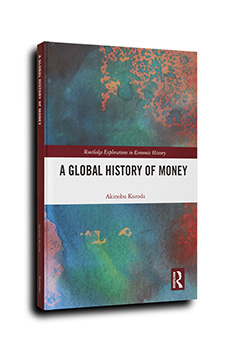書籍紹介
Akinobu Kuroda "A Global History of Money"
著者からの紹介

貨幣は交換の手段なのだけれども、交換という行いが人々の選択における自由度と交渉における制約の程度の差異によって多様であるので、貨幣も多元的に生成し、実際には複数の貨幣が補完しあう関係が現れる。
世界史上、人類の多数を占めてきた農民たちは直接かつ多数で交渉できる範囲で交換できるよう様々に取り決めを構成するが、間接二者間交渉を仲介するための手段とは可変的な接続にしておくことで、交換の安定性が担保されてきた。その可変的な関係が失われていく過程としての人類の歴史を明らかにすることが本書の企図である。
13世紀、モンゴル帝国下において全ユーラシア規模で貢納送付が交錯したことによる隔地取引での共通貨幣単位の出現が導火線となり、16世紀末からの銀の全地球的流通が現地取引と隔地取引の関係を再構成させていき、可変接続と固定接続の機構がせめぎあうが、19世紀末からの国際金本位体制のもと、人々が高い自由度をもって直接交渉する交換を支える仕組みは抵抗しつつも、確定性を高めることに傾斜した仕組みに吸収されていく。
確定性と安定性の識別をしない政治経済学は如上のような人類の大多数の営みを考慮することなく、往々にして目的論的な言説に安住してきた。
Table of Contents
| List of Figures |
|---|
| List of Tables |
| List of Abbreviations |
| Acknowledgements |
| Introduction |
| 1. Peasants Use Money |
| 2. The Four Quadrants of Exchange |
| 3. Exchange and Institutional Setting |
| 4. The Global History of Money Viewed from the Ground |
| 5. Bad Money Does Not Drive Out Good Money: Literature |
| Part 1 Exchanges Generate Money Locally |
| Chapter 1. Peasants, Marketplace, and Money |
| 1. Peasants Exchange with Peasants Anonymously |
| 2. Marketplaces for One-Time Transactions |
| 3. Natives Preferred Local Currencies |
| 4. Ubiquitous Fractional Currencies and Petit Exchangers |
| 5. Subsequent Transactions Not Through the Marketplace: Another Configuration between Peasants and Merchants |
| 6. Honour Substitutes for Cash |
| 7. Freedom or Certainty: Two Paths (not Stages) of Local Commercialization |
| Chapter 2. Stagnant Currencies and Stratified Markets |
| 1. Exogenous Currencies Naturally Stagnate |
| 2. Stratified Markets in Agricultural Societies |
| 3. Unidirectional Streams of Small Currencies and Local Imitations |
| 4. Informal Agreements Generate Endogenous Currencies |
| 5. How Merchants Acted in Stratified Markets |
| 6. Currency Circuits and Imaginary Money |
| Part 2 A Global History of Monetary Delocalization |
| Chapter 3. The Ignition of Monetary Delocalization: An Unexpected Remnant of the Mongolian Regime, c.1300 |
| 1. Independent Monetary Systems in Pre-13th Century Civilizations |
| 2. The Eurasian Silver Century: Emergence and Collapse |
| 3. The Mongolian Taxation System Depended on Commerce |
| 4. Paper Monies Drove Chinese Silver Ingots out to the West |
| 5. Copper Coins Driven East and South |
| 6. Commensurability Prevailed across Eurasia |
| 7. The Eurasian Age of Commerce: The Synchronised Emergence of Marketplaces |
| 8. Sprouting of Credit-Oriented Systems in Europe: One Aftermath |
| 9. Currency Circuits with ‘Old’ Coins Flourished across the China Sea: Another Aftermath |
| 10. Linkage to the Second Silver Century |
| Chapter 4. The World Diversified and Stratified: Three Paths after the Global Silver March, c.1600 |
| 1. A Breakthrough with Large Silver Coins |
| 2. A Silver Century Followed by a Copper Century |
| 3. Empires Thrived with Local Currencies: Prosperity in a Currency-Oriented Economy |
| 4. States Organised Debts Nationwide: Formation of a Credit-Oriented Economy |
| 5. Local Paper Monies Reveal Differences among Institutions: A Comparison between England, China and Japan |
| 6. Currencies, Marketplaces, and Early Industrialization: What Happened to Cement Currency Circuits? |
| 7. A Third Path: Commercial Oligarchies |
| Chapter 5. Nationalised Money: The Backstage of the International Gold Standard Regime, c.1900 |
| 1. The Age of International Silver Dollars: An Alternative to the Territorial Currency System |
| 2. The Riddle of the Maria Theresa Dollar |
| 3. The Reality of the Maria Theresa Dollar’s Circulation |
| 4. Currencies Working as Complementary Buffers: Currency Circuits Survived |
| 5. Paper Monies Nationalised Peasant Economies |
| 6. How Did Banknotes Reach Down to the Ground? The Case of Inter-War China |
| 7. Seasonality and Temporality of Monetary Demand Still Mattered: Towards 1929 |
| 8. The Paper Money Standard in China in 1935: Unification at the Top and Variety on the Ground |
| Conclusion: Money as a Social Circuit |
| 1. Global History of Monetary Delocalization |
| 2. Modern ‘Common Sense’ Uncommon in History |
| 3. Misuse of the Concept of Arbitrage: No Equilibrium Amidst Streams |
| 4. Escaping the Teleology of Monetary Studies |
| 5. Alternative Ideas about Money by Contemporaries |
| 6. Institutions for Flexibility as well as for Certainty: The Market Cannot Integrate by Itself |
| Appendix |
情報
黒田明伸
著
"A Global History of Money"
Routledge, 214ページ, 2020年4月, ISBN: 978-0-3678-5923-7
東洋文化研究所教員の著作

